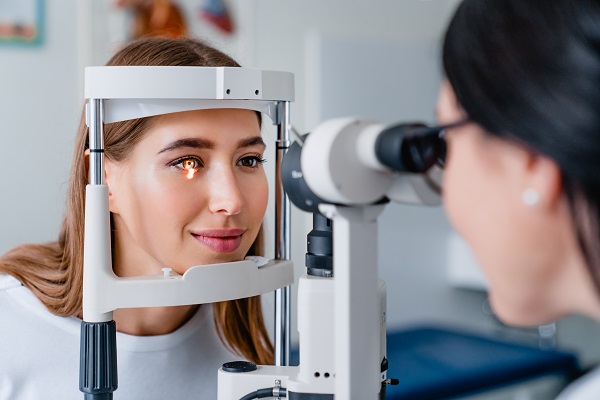Glaucoma Checks at Optometry Appointment

You have an optometry appointment on the horizon and you are curious about glaucoma checks. You know these checks are important to protect your eyes, but you are not sure what they entail. Learn more about the glaucoma checks you will undergo at your optometrist’s office. Then you will be prepared for your appointment.
Types of glaucoma checks during an optometry appointment
In the early stages, most people with glaucoma do not have any symptoms. However, as the disease progresses, symptoms such as severe eye pain, visual disturbance and blurred vision can occur. Untreated glaucoma can also lead to blindness. Because symptoms are not noticeable in the early stages, getting tested is critical.
An optometrist must run various tests to determine if a patient has glaucoma. Most use five different tests. The results of the tests are analyzed to provide a diagnosis. Learn more about each of the five tests.
Perimetry
The eye doctor will conduct a perimetry test. This visual field test allows the optometrist to check the patient’s field of vision. The patient will look ahead and look for light that passes along the peripheral vision. The patient lets the eye know when the light appears. After the test, the optometrist maps the patient’s field of vision.
Tonometry
An optometrist measures the pressure in the eye with a tonometry test. The optometrist begins by putting numbing drops in the eyes. Then, the eye doctor presses an instrument to the outside of the eye. The instrument reads the amount of pressure in the eye.
Pachymetry
The eye doctor must measure the thickness of the cornea when testing for glaucoma. This is done with a pachymetry exam. The optometrist uses a small probe to check the thickness. It is placed on the cornea. The thickness of the cornea plays a role in eye pressure readings. This information will help the eye doctor determine if the patient has glaucoma.
Ophthalmoscopy
The eye doctor will also conduct an ophthalmoscopy to look at the optic nerve. The eye doctor dilates the pupil to provide a better look at the optic nerve. The eye is examined with a small device that has lights and magnifies the optic nerve. This device checks the intraocular pressure.
Gonioscopy
The optometrist places numbing drops in the eye. Once the eyes are numb, the eye doctor inserts contact lenses. The mirrored lenses allow the optometrist to examine the angle of the cornea and iris. If the angle is too big or too small, the patient might have glaucoma.
Get tested for glaucoma at an optometry appointment
Do not wait to get tested until you have signs of glaucoma. Instead, visit the optometrist and get tested so if you do have it, it can be caught and treated early. Your eye doctor will run a perimetry, tonometry, pachymetry, ophthalmoscopy and gonioscopy test. Each test will provide important information to help the eye doctor diagnose or rule out glaucoma.
Request an appointment here: https://www.texasoptical.net or call Texas Optical at (214) 771-7333 for an appointment in our Dallas office.
Check out what others are saying about our services on Yelp: Read our Yelp reviews.
Recent Posts
Prescription contacts provide vision correction, comfort, and convenience for those who do not want to wear glasses. However, caring for and wearing contacts takes some getting used to. Learning to insert, remove, and maintain them will help ensure a comfortable and safe experience.Not all contact lenses are the same, and choosing the right pair is…
If you are thinking about seeing an optometrist, you should first look at your options. When you understand what this doctor does, you can make the right choice for your eye health. Other medical professionals help patients with their eyes too. So, it is important that you get the relief and treatment you need.People depend…
With digital screens occupying the majority of our lives, concerns about eye strain and potential long-term effects have increased the popularity of blue light glasses. Many individuals who spend extended hours in front of screens in their personal and professional lives seek practical solutions to alleviate symptoms associated with prolonged exposure to artificial lighting. Fortunately,…
Visiting an optometrist for a vision test is an important first step in protecting one of your most valuable assets —your eyesight. A professional assessment is key whether you are concerned about changes in your eyesight or addressing potential eye health issues. Discover the many benefits of scheduling a vision test and how it can…


